

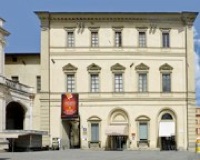
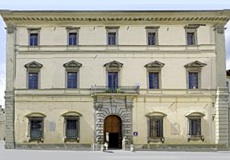
Left facade in Piazza Valerio Gildoni Main facade in Piazza Andrea Costa
This palace, which was the main residence of the Bufalini family, originally had its facade in what is now Piazza Andrea Costa, which was laid out in its present form in 1767, as part of a restoration project put in hand by Cardinal Giovanni Ottavio Bufalini. The left wall of the palace was originally obscured by the adjacent church of San Fortunato. However, this church was demolished in 1899, at which point a new side facade was built in what was then in the eastern part of Piazza Matteotti (recently renamed as Piazza Valerio Gildoni).
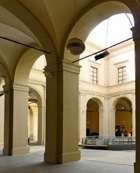
History of the Palace
The palace was built by Giulio Bufalini and his third wife, Francesca Turina. The original architect is unknown: the upper part of the unfinished main facade was completed by Tommaso Catrani as part of the restoration of 1767.
The earthquake of 1789 severely damaged the newly-restored palace. At some time thereafter, the family acquired the nearby Palazzo Vitelli in Piazza, which became their main residence in the city. (See also this website on Castello Bufalini, which is at San Giustino, some 10 km north of Città di Castello).
The Jesuits, who had operated a college at Sant’ Antonio Abate until their suppression in 1773, planned to return to Città di Castello after their re-instigation in 1814. They faced considerable opposition, but they finally seemed to be succeeding in 1844. They negotiated a 99 year lease on Palazzo Bufalini with Luigi Bufalini in order to build a new college, and secured the approval of Pope Pius IX for the project. However, the political situation deteriorated, and they were driven from the city in 1848.
Palazzo Bufalini then passed to the Commune. The Pinacoteca Comunale was established on the second floor in 1868 and remained there until 876. The Commune began the restoration of the palace in 1877.
Art and the Bufalini Family
Pintoricchio
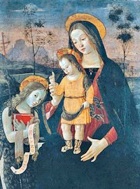
Il Parmigianino
In his life of il Parmigianino, (Girolamo Francesco Maria Mazzola), Giorgio Vasari mentioned two commissions from the Bufalini family:
-
✴By far the more important of the two was a panel that il Parmigianino was “commissioned to paint for Madonna Maria Bufalini of Città di Castello ... which was to be placed in San Salvatore del Lauro [in Rome]. He painted in it a Madonna in the sky, who is reading and has the Child between her knees, and on the earth he made a figure of St John, kneeling on one knee in an attitude of extraordinary beauty, turning his body and pointing to the Infant Christ; and lying asleep on the ground, in foreshortening, is a St Jerome in Penitence”.
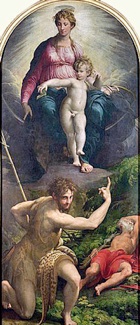
-
Maria was the daughter of Nicolò di Manno Bufalini (above). Il Parmigianino was at work on this commission when imperial forces sacked Rome, but was able to hide it before fleeing from the city. Giulio Bufalini brought it to the family chapel in Sant’ Agostino in 1558. The friars sold it to an English collector soon after the earthquake of 1789, and it is now in the National Gallery, London.
-
✴Vasari also mentioned “a picture of some nymphs [by il Parmigianino], which is now in the house of Messer Nicolò Bufalini at Città di Castello”. This painting, which no longer survives, was presumably once in Palazzo Vecchio Bufalini.

